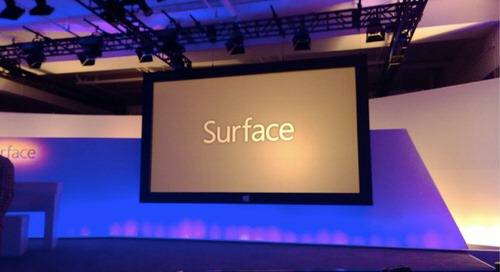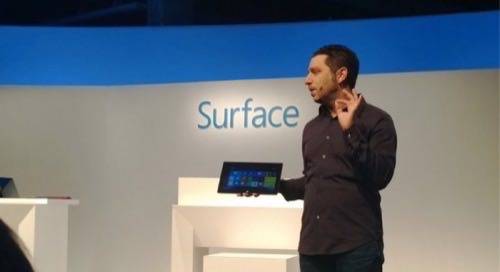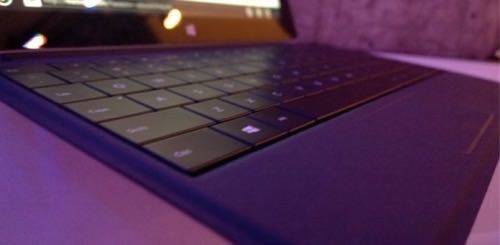Microsoft has remade its Surface Tablets running Windows 8—the Surface Pro 2 and Surface 2. They are thinner, brighter, more powerful and faster. Speeds and feeds remains the name of the game at Microsoft.
And that’s one of the biggest problems at Microsoft … and with the Surface 2 line.
What Microsoft Wants You To Know
The Surface Pro 2 is a full tablet/laptop hybrid running Windows 8.1 on the new x86 Haswell chip from Intel. The battery life is now 75% longer compared to the original Surface Pro. The device sports USB 3.0 ports. Microsoft even wants you to know that it upgraded the kickstand that holds the tablet upright (it now has two settings instead of one). The 64 GB Surface Pro 2 will start at $899 and ship on October 22.

The Surface 2 is the next generation of the Surface RT, the tablet that forced Microsoft to take close to a billion-dollars writeoff earlier this year. The Surface 2 runs on an ARM-based NVIDIA Tegra 4 processor, has improved multitasking capabilities and ships with the full Office suite of products for free. The Surface 2 will retail at $449 and also be available on Oct. 22.
Pre-orders for both the Surface 2 and the Surface Pro 2 start tomorrow.
Microsoft will also still sell the original Surface RT, starting at $349. Considering that Microsoft hardly sold any RT tablets after they were announced last year, we should expect it to stick around for a while as Microsoft works through its backlog of available stock.
Microsoft is aiming the Surface Pro 2 at professionals. Microsoft touts it as a full laptop replacement. It will come in both 4 GB and 8 GB of RAM versions, giving it the same type of computing power as most laptops (for reference, the most recent versions of the MacBook Air run at 8 GB of RAM).
“This product is about everything that Microsoft has to offer,” said Panos Panay, Microsoft’s VP of Surface at the launch event in New York City.
Feel The Power, Though It’s Beside The Point
As has long been its wont, Microsoft is focusing on the power and speed of its new products. Panay showed offed the Surface Pro 2 running raw 6K video from a RED HD camera during the event, showing that the Surface Pro 2 is capable of handling just about any type of data.
Panay lampooned the crowd of reporters (most of them using MacBooks), saying that the Surface Pro 2 was faster than 95% of other laptops on the market—implying, of course, that the Microsoft tablet performs better than both Apple’s iPad and laptops.

“This is power,” Panay said. “This is what it is like to have the full power of a PC on a tablet.”
The tablet is both cooler and quieter than the original Surface Pro. Microsoft says that it has 46% better color accuracy on its 10.6-inch screen (1920×1080 resolution). Both the tablets can be used with the new Microsoft Power Cover, a detachable keyboard that can increase the battery life of the device by 50%.
To its credit, Microsoft really has created a new breed of device with its Surface tablets and, more broadly, the Windows 8 device ecosystem in general. But Microsoft is making a mistake with the Surface 2 and the Pro 2 by focusing on the hardware specifications.
What Microsoft Should Be Telling You
Most computers users have a general idea of what RAM is and what it does to make computers run. At the same time, most people have little idea of the difference between a x86 chip made by Intel and an ARM chip made by manufacturers like NVIDIA, Samsung or Qualcomm. Microsoft touted its two new Surface products today with two main words: power and fast.

When Microsoft executives get on stage and start tweaking an audience that’s largely composed of Mac and iOS users, implying that their devices are slow, the message is lost. Why does Apple do well? Because its message its about style and design, utility and functionality. Yes, Apple will tout its speeds (especially with its new iPhone 5S and the Mac Pro), but it does so in a way that casts technical specs as supporting features—ones that make possible the experience of actually using the gadgets.
Microsoft’s message: Power and the speed are the features. Recent history has not offered a lot of support for the notion that consumers are primarily interested in raw performance details.
The biggest topic in technology over the last week wasn’t the iPhone 5S or the iPhone 5C. The hardware is tangential to the bigger story. It was iOS 7. Why? Because almost everybody who owns an iDevice was getting the newest version of the Apple’s operating system. It affected more people than just those that were looking for the new gold version of the iPhone 5S.
The difference between Apple and Microsoft is that Apple has made iOS something that people know about and care about. It doesn’t matter how powerful the Surface Pro 2 or the Surface 2 are, if people don’t care about Windows 8. And if they don’t care about Windows 8 and how it makes their lives easier or better in some way, then the Surface line will continue to be a massive failure for Microsoft, no matter how long it talks about turning itself into a devices and services company.









